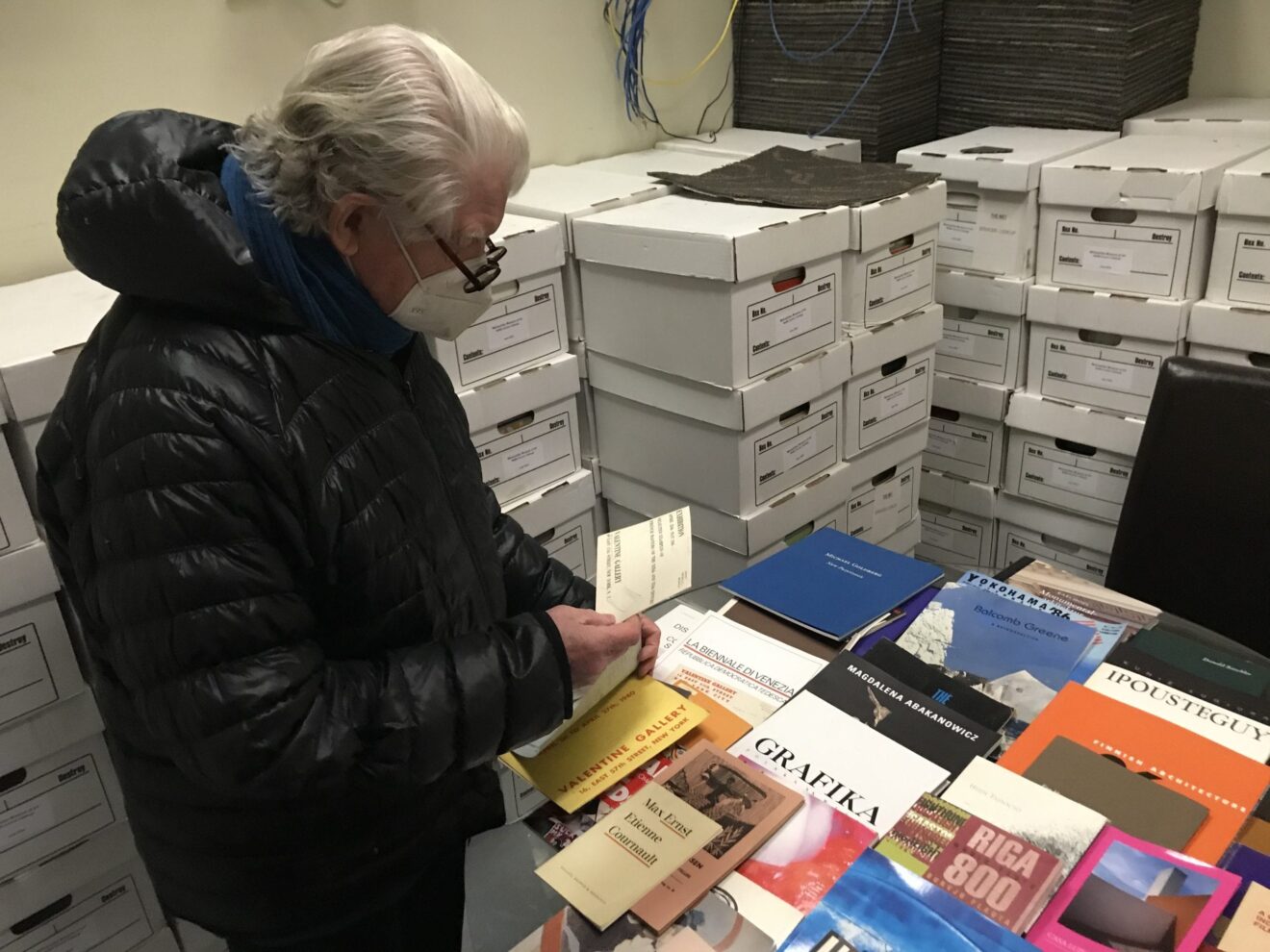NEW LONDON — Off the atrium of Harris Place is a room dominated by a long, low wooden table set with reading lamps. A few shelves of art books and one or two display cases containing art catalogues and ephemera dot the periphery. On the back wall, a large painting, “Calagrande” by Michael Goldberg, sets the mood.
The reading room, at 165 State St., serves as an unassuming portal to the Visual Art Library, a collection of more than 70,000 contemporary art books, catalogues, magazines and media assembled by George Waterman III, a contemporary art collector who became fascinated with art literature in the 1960s.
“When a gallery, for instance, in New York, decides that they have to close their doors and they have a back catalogue from like the 1960s, they donate it to us,” said Aly Maderson Quinlog, outreach coordinator for the library.
The ever-growing cache is housed in a maze of rooms just up the street in the Manwaring building, which Waterman purchased along with Harris Place in 1985. The books needed a home, said Waterman, who studied Renaissance art at Harvard University.
“After 10 or 15 years, into the late 1990s, there just wasn’t room in my apartment,” said Waterman. “There was room to move the library [in the Manwaring building] and it had floor loads that could take the weight of the library,” he said.

Many boxes of catalogues, books and ephemera have yet to be unpacked and catalogued, a task normally done by volunteers and interns, said Maderson Quinlog, who is also a book artist and art educator.
The library does not lend its materials. Members of the public can request items and read them on site in the Harris Place room.
In 2017, the library began using the Online Computer Library Center international database, or OCLC, and that database will be supplemented with Koha library software.
“We’re at the point where we need to get somebody with knowledge of library science to help us put in place the procedures,” said Waterman. “We need to make the library fully accessible, not digitally, necessarily, but accessible, searchable. So if you’re interested in DeKooning, for example, of which we have many, many books, you hit the button, and we’ve got 30 or 40 books on DeKooning, you can pick what you want and then we bring it over to the reading room to be studied here.”
The library is fundraising for a full-time librarian and an IT specialist. Until the collection is catalogued and at least partly digitized, Maderson Quinlog said they work to give the public access through social media, especially Instagram.
“For now my job is to share what I can and I feel like I curate little bits of the culture,” they said.
In one back room, waiting to be unpacked, were 260 boxes of catalogues from the Metropolitan Museum of Art. The entire collection, made up of duplicates and extra pieces the museum did not want, had been donated to Housing Works, a nonprofit in New York City — Waterman purchased all 260 boxes in 2020.
“There are probably 6,000 or 8,000 catalogues in those boxes,” said Waterman.
Maderson Quinlog, who has worked for the library for four years, said many of the older catalogues were printed on small printing presses and contain art pieces printed using lithographic techniques rarely seen today. Some of the pieces are works of art in themselves, some contain tiny sculptures, some are made with paper made by the artist, some are interactive and contain special boxes within boxes that must be opened in sequence.
The experience of seeing a piece of art in a book is not the same as seeing the object in person, but it is an art experience, they said.

“Particularly in contemporary art some people are afraid to go into galleries because they can be intimidating. There’s like the white box kind of effect,” they said.
Some pieces require special gloves to protect the paper, but many of the volumes can be held and touched, a process that Maderson Quinlog encouraged.
“While kids do love their screens, there is something particular about holding a book in your hand,” they said.
Waterman said he hoped the collection would become the best library of contemporary art after 1945 worldwide.
“Unlike a digital library where everybody is going these days, this is a library for the real books. and the real material. And lots of the material is small catalogues,” he said. “In 50 years time, those will be very hard to find — and 50 years goes pretty quickly.”
To make an appointment at the library during COVID, send an email to Aly@visualartlibrary.org.

